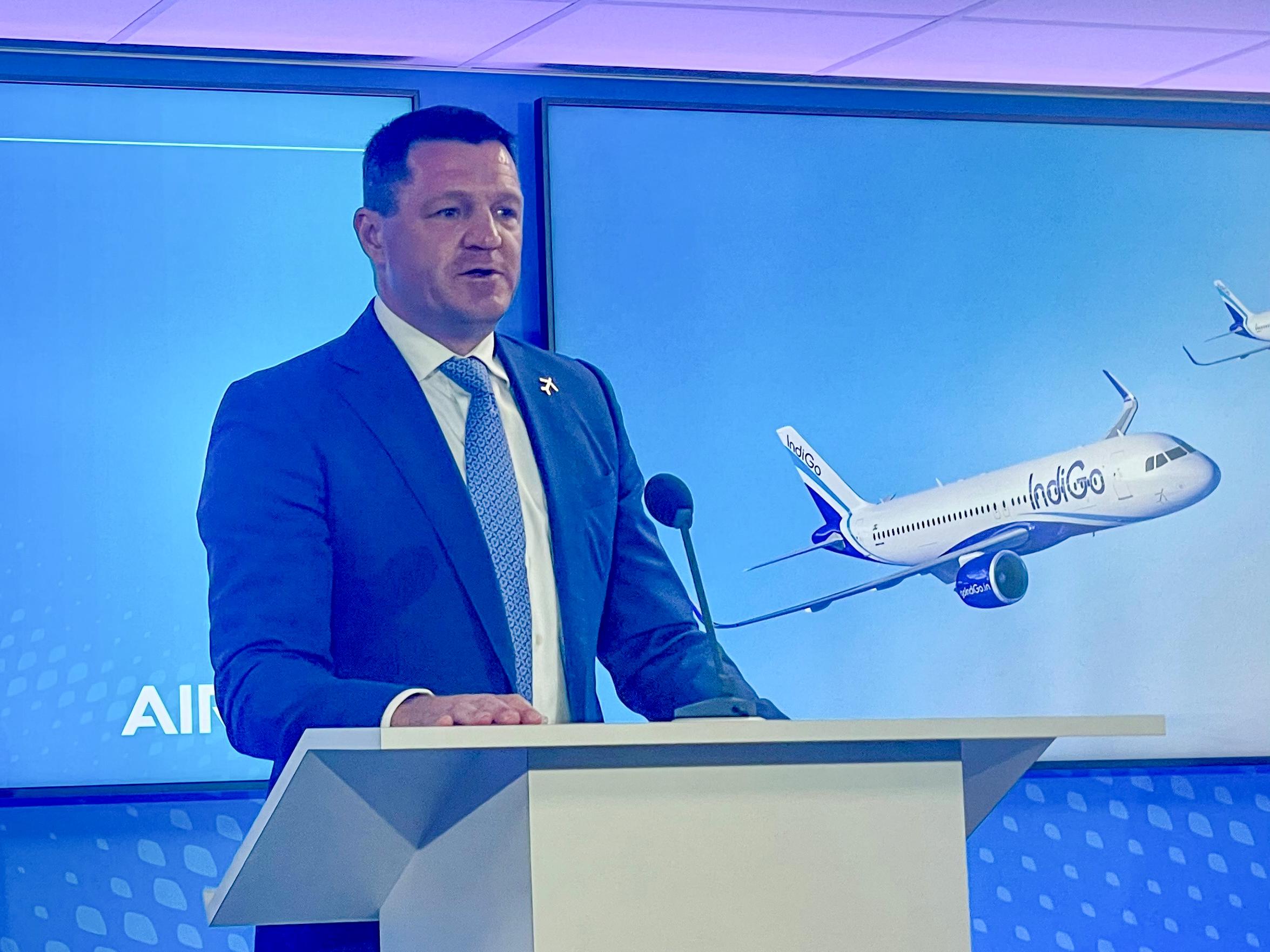
IndiGo CEO Pieter Elbers discusses the airline's order for 500 Airbus A320 family aircraft at the Paris Air Show.
The Paris Air Show returned this week after a four-year gap imposed by the pandemic. For the most part, it looked much like the last show in June 2019. Planes new and not-so-new took part in the flying and static displays; hordes of press crammed into chalets for contract signing photo-ops; the weather veered from wet to hot, to wet-and-hot.
But each show has its signature and, on the commercial air transport side, Paris ’23 was where India made its mark.
LCC IndiGo, now India’s largest domestic airline ahead of Air India, firmed an order for 500 Airbus A320 family aircraft. Then Air India finalized orders with Airbus for 140 A320neos and 70 A321neos, as well as 34 A350-1000s and six A350-900s. Air India spread the love across OEMs, also confirming a deal with Boeing for 190 737 MAXs, 20 787s and 10 777Xs, with options for 50 737 MAXs and 20 787s. Finally, Mumbai-based startup Akasa Air firmed its order for four additional Boeing 737 MAX 8s, taking the carrier’s order book to 76.
Never mind that most of these “orders,” like other airliner deals “announced” at Paris, were not really new or surprises. Commitments were made public months earlier; the signings at Le Bourget were about PR and it’s-good-to-be-back flourish. If this trend continues, the commercial story headlines for all future air shows will be written weeks ahead: Just slot in photo of CEOs with pens and thumbs up.
The real question is whether the ink in all these Indian deal signings will remain bright or, as so often in Indian aviation history, fade into disarray and bankruptcy? Air India has been through multiple restructurings and failed privatizations. Remember Kingfisher Airlines, at one time India’s fastest-growing carrier, which became the country’s second largest before it sank under massive debt in 2012?
What has changed to provide confidence that this time, India’s airlines can afford their massive new fleets and, more importantly, make money from them?
First, there’s been big changes in management at the two largest carriers. Air India is now fully owned by Tata Group, which is merging with Vistara, in which Singapore Airlines has a 49% stake. Under that deal, to be completed next year, Singapore Airlines will get a 25% stake in the merged Air India-Vistara, which will be a single airline branded Air India. Air India’s CEO since June 2022 is Campbell Wilson, the former CEO at Singapore Airlines’ very successful LCC, Scoot.
So there’s a lot of sound business savvy and know-how overseeing Air India, which is finally free of its government ownership shackles.
Similarly, IndiGo is now run by Pieter Elbers, a former CEO and long-time executive at KLM. Elbers inherited a very different airline from Air India. It’s been operating just 16 years, was founded as a private company, going public in 2015, and has a good track record. Elbers pointed out at the Paris signing why he believed that trend would continue.
“The Indian market is one of the fastest-growing in the world and, with the rise of the Indian economy, we have a wonderful opportunity to continue to serve and to make air travel available for as many Indian customers as possible,” he said.
India’s aviation market is indeed growing rapidly, boosted by an expanding middle class. IATA estimates the market size, compared with 2019, will increase by 430 million additional air passenger journeys to and from and within the country by 2040.
The United Nations has also projected that India will overtake China in 2023 to become the world’s most populous country, with an estimated total of more than 1.4 billion. And China’s extended lockdown and border closures through the pandemic gave a boost to India’s aviation market, with many airlines switching focus from Chinese to Indian destinations.
During the same week as the Paris Air Show, US President Joe Biden is hosting a state visit for Indian Prime Minister Narendra Modi, where warm and strategically important relationships will be showcased and celebrated. That follows a terse meeting between US Secretary of State Anthony Blinken and Chinese leaders in Beijing that did little to thaw diplomatic tensions.
In aviation trend terms, at least, India is in, China is out. That could switch by Farnborough ’24—it’s hard to see Indian carriers placing even more deals in the hundreds-of-aircraft size and would probably be concerning if it happens.
But for now, India’s airlines are going full throttle for growth and, finally, long-term success.

Comments